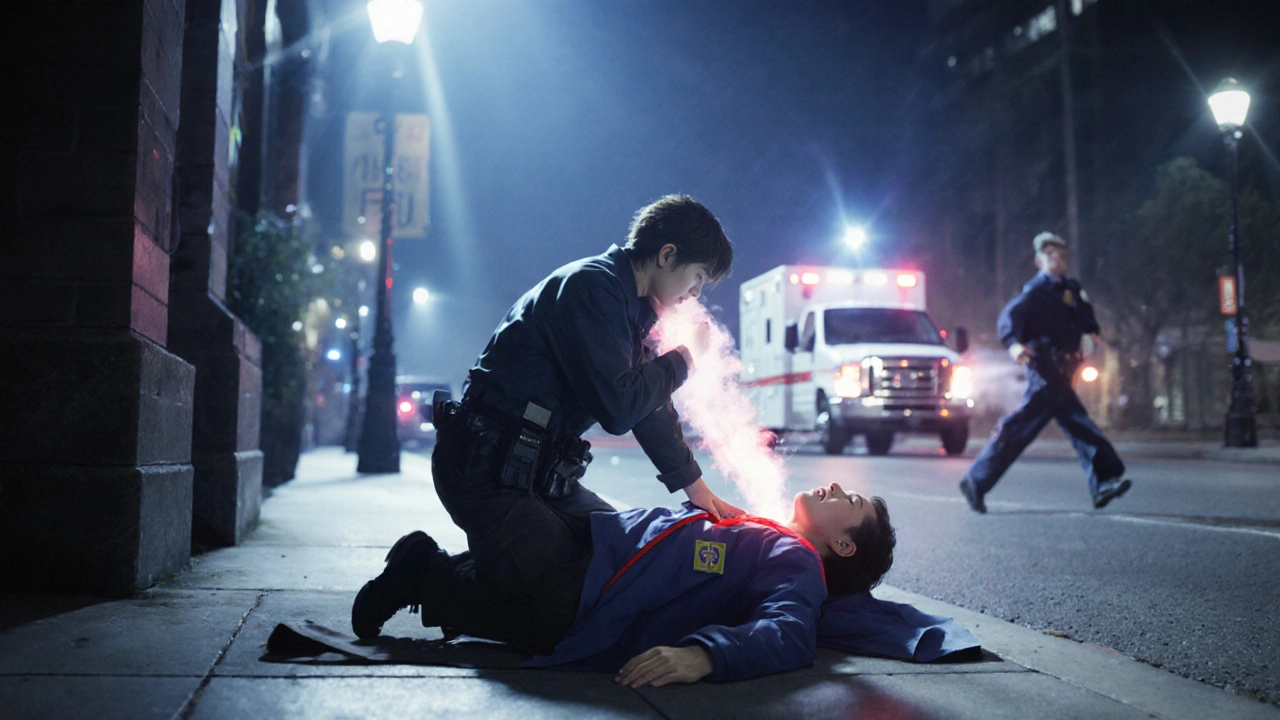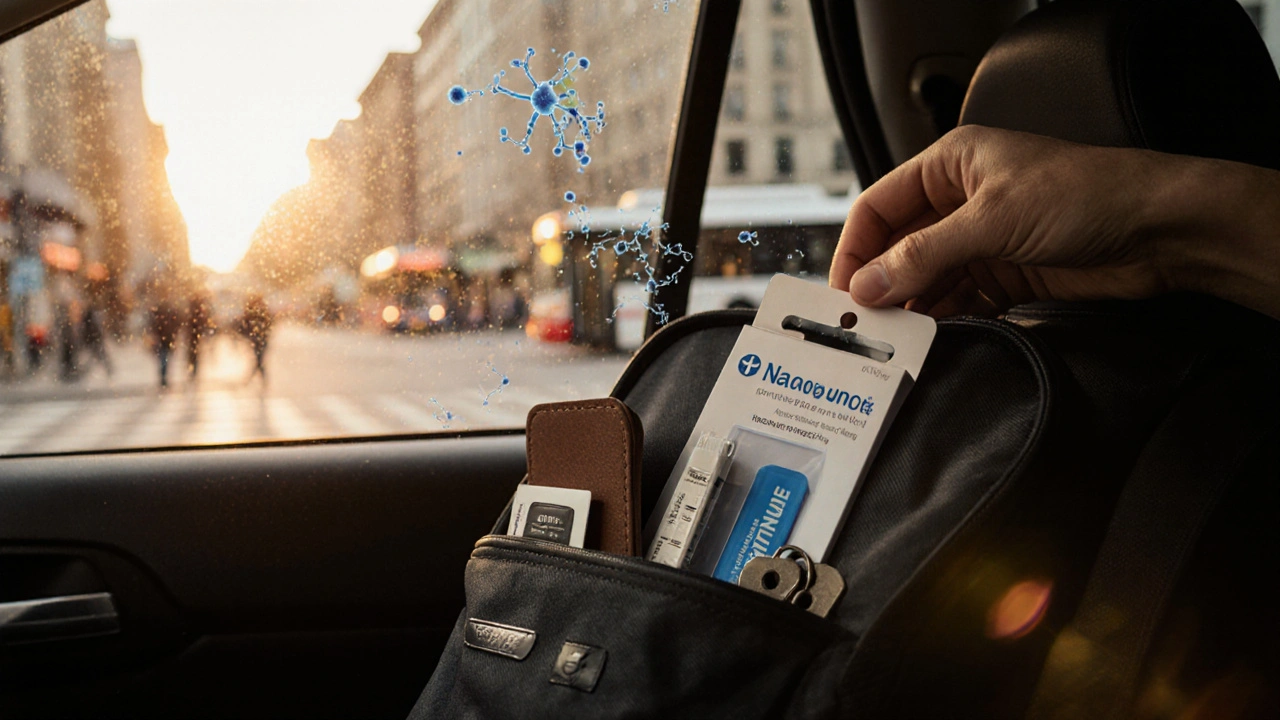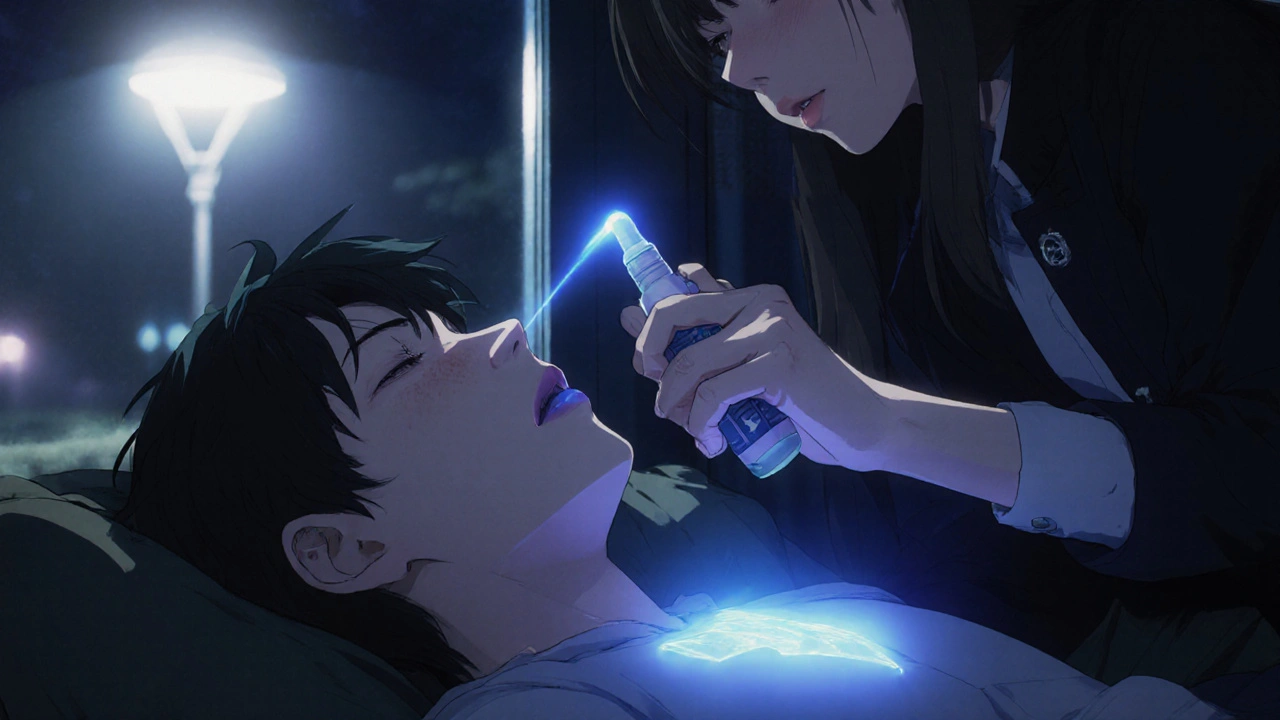Every day, 187 people in the U.S. die from drug overdoses. Most of those deaths involve opioids - drugs like heroin, oxycodone, fentanyl, and morphine. And here’s the hard truth: opioid overdose doesn’t always look like what you see in movies. It’s not always someone slumped on the floor with a needle in their arm. Sometimes, it’s a person who just won’t wake up after taking what they thought was a pain pill. Or a teenager who took a pill they found in a medicine cabinet. Or a parent who used a drug they thought was safe because it came in a pill form.
If you’re reading this, you might be worried about someone. Or you’re trying to be prepared. Either way, knowing what to look for and what to do could save a life - maybe even your own.
What Happens During an Opioid Overdose?
Opioids work by attaching to receptors in your brain that control pain - but they also mess with the part that tells your body to breathe. When too much of the drug is in your system, those breathing signals shut down. Oxygen stops reaching your brain. Within minutes, brain cells begin to die. You can lose consciousness. Your lips and fingernails turn blue or gray. You might make gurgling or snoring sounds - not because you’re asleep, but because your airway is collapsing.
This isn’t a slow process. It’s fast. And it’s silent. People don’t scream. They don’t thrash. They just stop responding. That’s why bystanders often don’t realize it’s happening until it’s too late.
Signs of an Opioid Overdose
You don’t need to be a doctor to spot an overdose. Look for these three key signs - the classic triad:
- Unresponsive or unconscious - No matter how much you shake or shout, the person won’t wake up. Try rubbing your knuckles hard on their chest bone. If they don’t react, they’re in trouble.
- Slow, shallow, or stopped breathing - Watch their chest. Are they taking fewer than 12 breaths a minute? Or none at all? That’s a red flag.
- Pinpoint pupils - Their pupils will look like tiny dots, even in dim light. But here’s the catch: not everyone has this sign. Don’t wait for it.
Other warning signs include:
- Blue, purple, or gray lips and fingertips
- Cold, clammy, or pale skin
- Limp body - like a ragdoll
- Gurgling, choking, or snoring sounds
- Extreme drowsiness - they can’t stay awake
And here’s something many people don’t know: fentanyl, a synthetic opioid 50 to 100 times stronger than morphine, is now mixed into almost every kind of street drug - cocaine, counterfeit Xanax, even pills sold as “OxyContin.” You don’t have to be using heroin to overdose. You just have to take something that contains fentanyl - and you might not even know it.
What to Do If Someone Is Overdosing
Time is everything. Brain damage starts after just 4 to 6 minutes without oxygen. So don’t wait. Don’t call a friend first. Don’t try to wake them up by slapping them. Don’t put them in a cold shower. Those things don’t work. Here’s what does:
- Call 911 right away. Say clearly: “I think someone is overdosing on opioids.” Give your location. Stay on the line. Dispatchers can walk you through steps while help is coming.
- Give naloxone if you have it. Naloxone (brand name Narcan) is a medication that blocks opioids from binding to brain receptors. It reverses the overdose. It’s safe. It won’t hurt someone who hasn’t taken opioids. If you’re unsure - give it anyway.
- Administer it correctly. Most naloxone today comes as a nasal spray. Tilt the person’s head back. Insert the nozzle into one nostril. Press the plunger all the way in. One spray is usually enough. If you only have the injectable version, give it into the thigh muscle, through clothing if needed.
- Start rescue breathing if they’re not breathing. Tilt their head back, pinch their nose, and give one breath every 5 seconds. Keep going until they breathe on their own or help arrives.
- Stay with them. Naloxone wears off in 30 to 90 minutes. Opioids can stay in the body much longer. The person can stop breathing again. Do not leave them alone. Even if they wake up, they need medical care.
Don’t worry about getting in trouble. In 49 states, Good Samaritan laws protect people who call 911 during an overdose. The goal is to save lives - not punish them.

How to Get Naloxone
You don’t need a prescription in most places. In Oregon, where I live, you can walk into any pharmacy and ask for naloxone. Pharmacists hand it out like cough syrup. The cost? Around $25 to $50 for a two-dose kit. Many community health centers, harm reduction programs, and even some libraries give it out for free.
Look for organizations like Safe Injection Sites, Project Lazarus, or your local health department. They often train people on how to use it - and give you a kit to take home. Keep one in your car. In your bag. In your coat pocket. You never know when you’ll need it.
And if you’re worried about someone using opioids - give them naloxone. Don’t wait for a crisis. Make it part of your care.
What Happens After Naloxone?
When naloxone works, the person wakes up. They might be scared. Angry. Confused. Some people say it feels like being punched in the chest. That’s because their body is going into withdrawal - suddenly cut off from the drug it’s used to.
That’s not the end. It’s the beginning. After an overdose, the body needs to be checked for damage. Oxygen deprivation can hurt the heart, kidneys, and brain. Even if they seem fine, they need to go to the hospital.
And here’s the most important part: overdose survivors are at the highest risk of dying from another overdose - especially in the first two weeks. That’s when tolerance drops. If they use the same amount they used before, they can die.
Recovery doesn’t happen overnight. But it can happen. Medications like methadone, buprenorphine, and naltrexone can help. Therapy helps. Support groups help. But none of that matters if they’re dead.

Why This Matters - And What You Can Do
Opioid overdose isn’t a moral failure. It’s a medical emergency. And like a heart attack, it’s preventable - if you know what to do.
You don’t need to be a first responder. You don’t need to be a doctor. You just need to know the signs. You need to know where to find naloxone. And you need to be willing to act - even if you’re scared.
Someone you love might be at risk. Or someone you don’t even know. Maybe it’s the person sitting next to you on the bus. Or the neighbor you wave to every morning. Maybe it’s you.
Don’t wait for someone else to step in. Be the person who acts. Carry naloxone. Know the signs. Call 911. Stay until help arrives.
Because in the middle of an overdose, the only thing that matters is this: you’re there. And you didn’t look away.
Can naloxone be used on someone who didn’t take opioids?
Yes, naloxone is safe to use even if you’re not sure what the person took. It only works on opioid receptors. If no opioids are in their system, it has no effect. It won’t cause harm, won’t make them sick, and won’t trigger withdrawal. When in doubt, give it.
How long does naloxone last, and can one dose be enough?
Naloxone typically works for 30 to 90 minutes. But many opioids - especially fentanyl - stay in the body much longer. That means the person can stop breathing again after naloxone wears off. That’s why you must call 911 and stay with them. Many overdoses require two or more doses of naloxone. Always assume you’ll need more than one.
Is naloxone available without a prescription?
Yes. In 49 U.S. states, you can buy naloxone over the counter at pharmacies without a prescription. Some states even allow pharmacies to dispense it under a standing order from a public health official. Many community programs give it away for free. Check with your local health department or harm reduction center.
Can fentanyl be detected in drugs before use?
Yes. Fentanyl test strips (FTS) are a low-cost harm reduction tool that can detect fentanyl in drugs. You dissolve a small sample in water, dip the strip, and wait a few minutes. If it shows fentanyl, you know the drug is dangerous. It doesn’t make drugs safe - but it gives you information to make smarter choices. Many harm reduction programs provide them for free.
What should I do if someone wakes up after naloxone but refuses to go to the hospital?
Even if they seem fine, they need medical care. Opioid overdose can cause hidden damage - like lung injury, heart rhythm problems, or brain swelling. Tell them that naloxone is temporary, and the risk of another overdose is very high. If they refuse, stay with them. Monitor their breathing. Call 911 if they show any signs of trouble again. Their life is worth the fight.
Are there side effects of naloxone?
For people who have opioids in their system, naloxone can cause sudden withdrawal symptoms - nausea, vomiting, sweating, agitation, or body aches. These are uncomfortable but not life-threatening. For people without opioids, there are no side effects. The benefits of saving a life far outweigh the risks of withdrawal.
Next Steps: Be Ready Before It Happens
Here’s what you can do today:
- Ask your pharmacist for naloxone - no prescription needed.
- Keep a kit in your car, purse, or backpack.
- Watch a 5-minute video on how to use naloxone (YouTube has free ones from CDC or Narcan).
- Teach one person how to recognize the signs and use it.
- Find your local harm reduction center. They often offer free training and supplies.
You don’t have to fix the opioid crisis. But you can save one life. And that’s more than enough.



11 Comments
Stephanie Deschenes November 26, 2025 AT 11:08
I’ve carried naloxone in my purse for two years now. Not because I know someone using opioids, but because you never know who might need it. I once used it on a stranger at a bus stop. He woke up confused, then started crying. We sat there until EMS arrived. No heroics. Just a spray and staying put.
Pharmacists in my town give it out like gum. Ask for it. Keep one in your car. You’re not enabling anyone-you’re just being human.
Cynthia Boen November 26, 2025 AT 15:59
This whole post is performative wokeness. People choose to do drugs. Why should I have to carry some magic spray because someone can’t control their impulses? Stop treating addiction like it’s a car accident. It’s not.
Amanda Meyer November 28, 2025 AT 07:40
While I appreciate the intent behind this guide, I must push back on the implication that naloxone is a complete solution. It’s a life-saving tool, yes-but it’s also a bandage on a systemic wound. We’re treating overdoses without addressing the root causes: trauma, poverty, lack of mental healthcare, and the pharmaceutical industry’s role in fueling this crisis.
Carrying naloxone is necessary. But it’s not enough. We need policy reform, decriminalization, and investment in harm reduction infrastructure-not just individual preparedness.
That said, I still keep a kit in my glovebox. Because even imperfect solutions save lives.
Wendy Edwards November 30, 2025 AT 05:20
my bf took a pill he thought was oxycotin and passed out last year. i had no clue what to do until i saw this exact guide on reddit. i gave him the naloxone i got from the free clinic and he woke up screaming like a banshee. he’s been clean 11 months now. i still keep two kits in my bag. just in case.
you dont need to be a hero. just be there.
Jaspreet Kaur November 30, 2025 AT 15:11
life is fragile and we pretend its not. we drive fast cars eat fast food and ignore the quiet people who are drowning in silence. naloxone is not magic. it is a mirror. it shows us we are not as far from tragedy as we think. if you can save someone with a spray and a breath then why not do it
we are all one bad decision away from needing help
Gina Banh December 1, 2025 AT 02:33
Fentanyl test strips are the real MVP. I hand them out like candy at parties now. If you’re gonna do something, at least know what you’re doing. One strip costs 2 bucks. A life? Priceless.
Also-naloxone doesn’t fix withdrawal. It just buys time. People wake up furious and scared. That’s not failure. That’s biology. Don’t abandon them after the spray.
Deirdre Wilson December 2, 2025 AT 06:59
I used to think overdose looked like TV drama-screaming, foaming, needles everywhere. Then I saw my cousin just… stop. Like a phone dying. No noise. Just gone. That’s the scariest part. It’s quiet. It’s sneaky. If you don’t know the signs, you won’t even realize it’s happening until it’s too late.
Now I carry naloxone. And I talk about it. Not to scare people. Just to make it normal.
Damon Stangherlin December 3, 2025 AT 13:39
Just got my first naloxone kit today from the pharmacy. The pharmacist asked if I wanted a training card too. I said yes. I’m not gonna lie-I was nervous asking. Felt weird. Like I was admitting something. But then I thought-what if I’m the one who saves someone? That’s worth the awkwardness.
Thanks for the guide. I’m sharing it with my roommates.
Ryan C December 4, 2025 AT 05:21
⚠️ CORRECTION: Naloxone does NOT work on non-opioid overdoses like cocaine or meth. But it’s still safe to administer if you’re unsure. It won’t kill them, but it won’t help either. Also, the CDC recommends 2 doses of Narcan for suspected fentanyl overdoses. Don’t be cheap with it. 🚨
And yes, test strips exist. Get them. They’re 99% accurate. Link in my bio if you need where to buy.
Dan Rua December 5, 2025 AT 13:31
My sister died of an overdose three years ago. I didn’t know how to help. I didn’t even know what to look for.
This post? It’s the thing I wish I’d had back then.
I bought two naloxone kits. Gave one to my mom. One to my brother. We all know how to use them now. Not because we’re saints. Just because we’re tired of losing people.
Thank you for writing this.
Mqondisi Gumede December 6, 2025 AT 20:26
Why are we giving free drugs to junkies instead of deporting them? This country is weak. In my homeland we lock up people who sell this poison. Not hand them spray to keep using. You want to save lives? Stop enabling. Make them suffer the consequences. Then maybe they’ll stop.
My people don’t need your pity. They need discipline